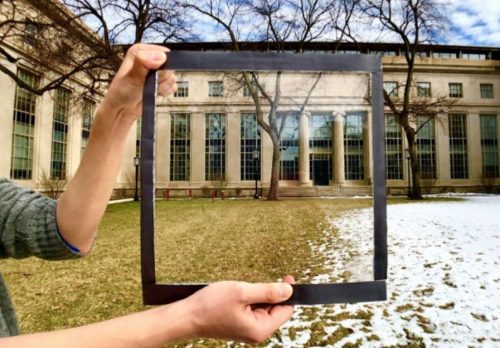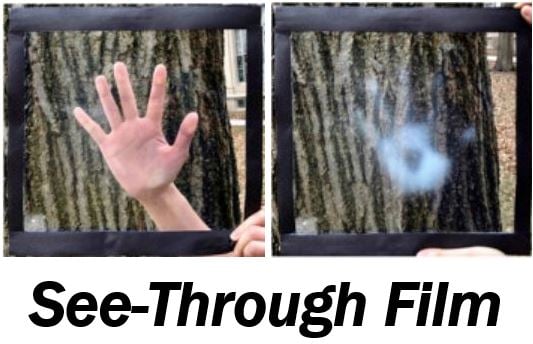A see-through film that blocks seventy percent of incoming solar heat could save on air-conditioning costs, say researchers. By coating windows with the see-through film, most of the incoming solar heat would not get in. Most residential and office buildings crank up the air-conditioning (A/C) during the hot summer months. Doing so significantly pushes up energy bills.
According to estimates, air conditioners consume approximately 6% of all the electricity that the United States generates. That six percent amounts to $29 billion. As temperatures globally rise, it is an expense that will certainly grow.
MIT engineers have developed a see-through film that rejects heat. They said it is possible to apply the film to a building’s windows. Windows would subsequently reflect up to 70% of incoming solar heat.
The see-through film remains highly transparent below 32°C (89°F). Above 32°C, it acts as an ‘autonomous system’ that blocks incoming heat.
If you covered every window of a building with this see-through film, the building’s A/C costs would decline by 10%.

See-through film – like transparent plastic wrap
The see-through film is like a transparent plastic wrap. Its heat-repelling properties come from minuscule microparticles embedded in it.
The microparticles consist of a kind of phase-changing material that shrinks when it is warm, i.e., 85°F+ (29.5°C+).
When the microparticles are more compact, they give the normally see-through film a more frosted or translucent look.
If you apply the film to windows in the summer, they could reduce solar heat penetrating through the window. However, they would still let in plenty of light.
According to Nicholas Xuanlai Fang, the see-through film provides an energy-efficient alternative to current smart window technologies. It is also an affordable option.
Fang is a Professor of Mechanical Engineering at MITEI (MIT Energy Initiative).
A better smart window option
Prof. Fang said:
“Smart windows on the market currently are either not very efficient in rejecting heat from the sun, or, like some electrochromic windows, they may need more power to drive them, so you would be paying to basically turn windows opaque.”
“We thought there might be room for new optical materials and coatings, to provide better smart window options.”
Prof. Fang and colleagues wrote about their work in the journal Joule (citation below). The other authors were Xin-Hao Li and Chang Liu, from MIT, and Shien-Ping Feng, from the University of Hong Kong.
Reducing energy usage in Hong Kong’s building
Slightly more than a year ago, Prof. Fang started collaborating with scientists at the University of Hong Kong. They wanted to find ways to minimize energy usage in buildings in the city, especially during the summer months. Summer in Hong Kong is notoriously hot, and air-conditioning usage peaks dramatically.
Referring to Hong Kong’s commitment to cut energy usage by 40% by 2025, Prof. Fang said:
“Meeting this challenge is critical for a metropolitan area like Hong Kong, where they are under a strict deadline for energy savings.”
Prof. Fang’s students calculated that a sizable portion of a building’s heat comes in through the windows. Specifically, in the form of sunlight (solar heat).
Prof. Fang said:
“It turns out that for every square meter, about 500 watts of energy in the form of heat are brought in by sunlight through a window. That’s equivalent to about five light bulbs.”
Prof. Fang’s group studied the light-scattering properties of exotic, phase-changing materials. He wondered whether it would be possible to fashion these optical materials into windows. If so, he also wondered whether they could passively reflect a considerable portion of a building’s incoming solar heat.
See-through film like a fishnet in water
The researchers read up on ‘thermochromic materials.’ These are temperature sensitive materials that change color or phase temporarily in response to heat.
Eventually, they landed on a material made from poly (N-isopropylacrylamide)-2-Aminoethylmethacrylate hydrochloride microparticles. These microparticles, which are filled with water, resemble tiny, transparent, fiber-webbed spheres.
When the temperature rises above 85°F (29.5°C), the spheres squeeze our all their water and shrink. They shrink into tiny fiber bundles that reflect light differently; the material becomes translucent.
Prof. Fang explained:
“It’s like a fishnet in water. Each of those fibers making the net, by themselves, reflects a certain amount of light.”
“But because there’s a lot of water embedded in the fishnet, each fiber is harder to see. But once you squeeze the water out, the fibers become visible.”
In previous studies, researchers found that shrunken particles could reject light fairly well. However, they were not so good at blocking heat.
Prof. Fang and colleagues realized that this limitation was due to size. In previous research, the particles, with a diameter of approximately 100 nanometers, were too small. That size is smaller than infrared light’s wavelength. Therefore, heat was passing through easily.
The new microparticles were bigger
In this latest research, the scientists expanded the molecular chain of each microparticle. When they shrank in response to heat, their diameter was about 500 nanometers. Five-hundred nanometers, Prof. Fang explained, is “more compatible to the infrared spectrum of solar light.”
The see-through film was created
The scientists created a solution of the heat-blocking microparticles. They applied the solution between two sheets of 12×12 inch glass and created a film-coated window.
The research team used a solar simulator to shine light onto the window, thus mimicking incoming sunlight. They found that the see-through film turned frosty in response to heat.
The measured the solar irradiance transmitted through the other side of the window. They found that the see-through film could block seventy percent of the solar simulator’s (lamp’s) heat.
Temperature in a small calorimetric chamber
The researchers also lined a small calorimetric chamber with the see-through film. They then measured the temperature inside the chamber as they shone the solar simulator’s light through the film.
The inner temperature reached 102°F (38.9°C) with no film, i.e., “about the temperature of a high fever,” Prof. Fang noted. With the see-through film, on the other hand, the inner chamber’s temperature remained at a more tolerable 93°F (33.9°C).
Prof. Fang said:
“That’s a big difference. You could make a big distinction in comfort.”
Xiaobo Yin, an Associate Professor of Mechanical Engineering at the University of Colorado at Boulder, said:
“Windows have been one major bottleneck of building efficiency. Smart windows that regulate solar energy intake can potentially be a game changer.”
“One great advantage of this work is the materials used, which substantially improve applicability and manufacturability of smart windows.”
The scientists say they will continue doing more tests with the see-through film. They want to see whether they can further improve its heat-shielding properties.
Citation
“Broadband Light Management with Thermochromic Hydrogel Microparticles for Smart Windows,” Xin-Hao Li, Chang Liu, Shien-Ping Feng, and Nicholas Xuanlai Fang. Joule. Published: November 8, 2018. DOI:https://doi.org/10.1016/j.joule.2018.10.019.

